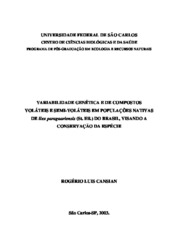Variabilidade genética e de compostos voláteis e semi-voláteis em populações nativas de llex paraguariensis (St. Hil.) do Brasil, visando a conservação da espécie
Resumen
Ilex paraguariensis, known as mate tea, is processed in many ways and commercialized as tea, soluble powder, essences, and processed leaves for preparation of mate tea without sugar ( chimarrão and tererê ). Aiming the conservation of this species, this work studied the intra- and interpopulational genetic variabilities of I. paraguariensis and its volatiles and semi-volatiles composition in 20 populations inside the area of incidence of this species in Brazil. Paternity tests were also performed to identify a favorable crossing for obtaining lineages with the characteristics
of interest, reducing then the impact of extractive harvest on the native plants. Genetic variability of I. paraguariensis analyzed by RAPD markers (Random Amplified Polymorphic DNA) is lower to the reported variability in other dioic arboreal species. Intrapopulational variability is higher than interpopulational in this species. In intra and interpopulational studies alleles with the same allele sequence were identified, as well as alleles with very different sequences, what evidences the incidence of genetic flux among populations that are close geographically, but with alleles specific of each population. The environmental differences taken into account were not enough to explain genetic and chemical differences found among the populations. These results show the possibility of influences of microenvironmental factors and non-analyzed genes in the analyzed chemical composition of mate tea leaves. The population of Ponta Porã, geographically separated from the others, proved to be genetically distinct. Species-specific fragments were obtained for I. paraguariensis, I. dumosa and I. theezans. However, more studies for confirmation and utilization of such fragments must be carried out. The differences in the volatiles and semivolatiles composition among the populations turned their separation possible, and may be useful for identification and inclusion of genotypes, superior in specific compounds, in germoplasm collections. For conservation of this species in germoplasm collections ex situ, material collecting must be based on genetic analysis, as well as on geographical distribution, due to the higher intrapopulational variability and occurrence of rare alleles in the species. The RAPD technique may be used for paternity identification, mainly in arboreal species, making possible to obtain genetic improvement by performing controlled crossings. Based on these results, it was possible the discussion concerning the conservation aspects of this species.
